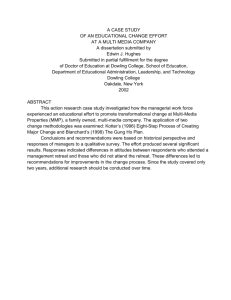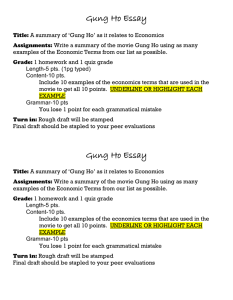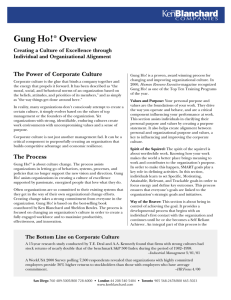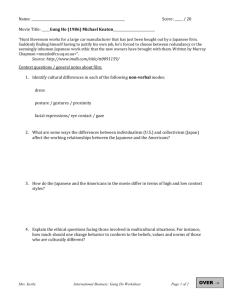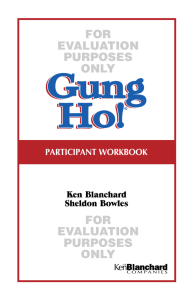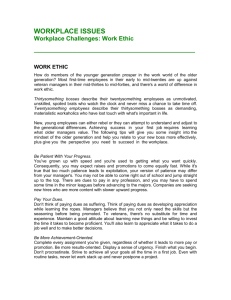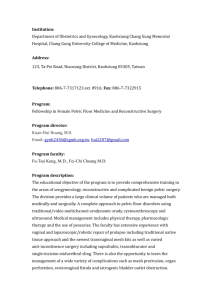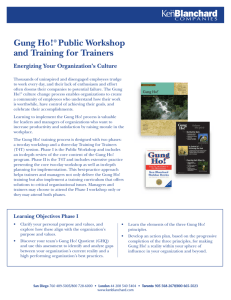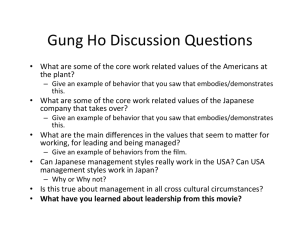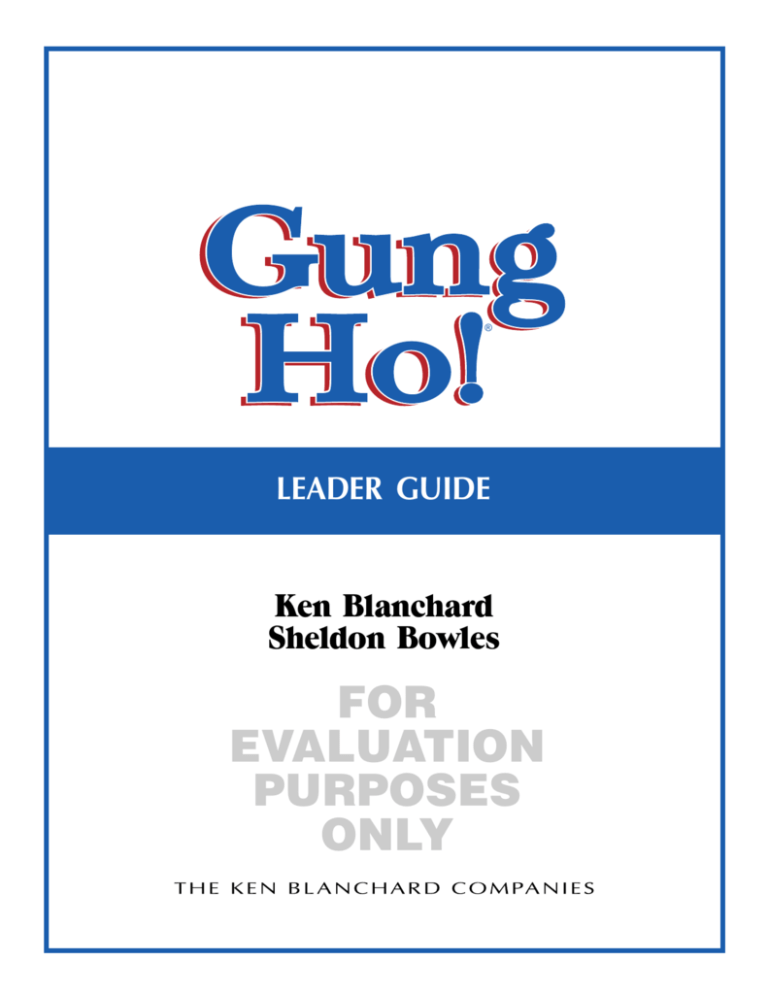
®
LEADER GUIDE
Ken Blanchard
Sheldon Bowles
FOR
EVALUATION
PURPOSES
ONLY
At The Ken Blanchard Companies, we
believe that people are the source of
business success. Despite growing
competition, downsizing, or upsizing,
training people to be the best they can be is the underlying strength of successful
organizations. Beyond budgets or products, nothing allows you to compete more
aggressively than people who are committed to organizational goals.
Since 1979, we have proudly designed and delivered some of the most effective
training products on the market. However, we believe that training products or
programs alone do not create adequate or lasting change in organizations.
Knowing that the power of training is unleashed only when it is tied to vision, we
have developed a foundation for sound management that links training with
business strategy.
FOR
Blanchard
Learning Materials
EVALUATION
PURPOSES
Blanchard Performance Systems
ONLY
The Ken Blanchard Companies now offers innovative solutions through six
business units to better serve you.
offers an extensive line of books, training
videos, audiotapes, assessments, and other performance-support training products
for individuals and organizations. 800 728-6052
provides improved employee and
organizational performance through high-impact training. 800 236-0499
Blanchard Center for Professional Development offers public
workshops and training-for-trainer programs in our core technology areas
including Situational Leadership® II, Building High Performing Teams®,
Situational Self Leadership, and Raving Fans®. 800 447-8749
Blanchard Solutions Group delivers consulting services in the areas of
strategy, purpose, vision, cultural change, leadership development, and customer
loyalty that create sustainable results. 800 795-4283
Blanchard International Group offers translated and culturally adapted
training products and programs for companies with global needs. 800 728-6000
Blanchard Speakers provides outstanding keynote and conference speakers
who specialize in a wide range of leadership, customer service, team building, and
organizational-development topics. 800 278-2896
®
LEADER GUIDE
FOR
EVALUATION
PURPOSES
ONLY
AUTHORS
Ken Blanchard
Sheldon Bowles
FOR
EVALUATION
PURPOSES
ONLY
PROJECT MANAGER
Mark Manning
PRODUCTION COORDINATOR
Ellen Long
LAYOUT AND DESIGN
Carla deBose
The materials in this workbook have been designed to develop certain and specific knowledge and skills. Much time and
effort have been spent writing and testing these materials to ensure they are effective for their purpose. All rights reserved.
No part of this publication may be reproduced, stored in a retrieval system, or transmitted in any form or by any other
means, electronic, mechanical, photocopying, recording, or otherwise, without the prior written permission of American
Media Inc., Blanchard Family Partnership, and Ode to Joy Limited.
Those pages which may be reproduced without permission are designated as such at the bottom of each reproducible page.
If you desire to customize or adapt these materials for your organization or to discuss a licensing agreement, please contact
your Blanchard representative at 800 728-6000. The Ken Blanchard Companies maintain a staff with extensive capabilities
to assist you in meeting your needs.
All changes, adaptations, or licensing rights to these materials must be requested and approved through The Ken Blanchard
Companies in writing.
Thank you!
125 State Place, Escondido, CA 92029 USA
San Diego 760 489-5005 • 800 728-6000 • Fax 760 489-8407
London 44 208 540 5404 Toronto 905 568-2678 • 800 665-5023
www.kenblanchard.com
Item # 10847
Web V091502
GUNG HO! LEADER’S GUIDE
TABLE OF CONTENTS
Preparation Materials
Introduction...................................................................................................... 2
Training Session Checklist ............................................................................... 3
Tips for Transferred Learning ......................................................................... 4
Possible Session Agendas ................................................................................. 5
Trainer’s Personalized Session Agenda ........................................................... 6
Invitation Memo to Participants ...................................................................... 7
Trainer’s Instructions for the Pretraining Survey .......................................... 8
FOR
EVALUATION
Training Materials
PURPOSES
ONLY
Introduce the Session to Participants............................................................ 10
Show Video and Review ................................................................................. 11
Spirit of the Squirrel Discussion .................................................................... 12
Key Learning Points: Spirit of the Squirrel................................................... 13
Spirit of the Squirrel Exercise........................................................................ 14
Way of the Beaver Discussion ......................................................................... 15
Key Learning Points: Way of the Beaver ....................................................... 16
Way of the Beaver Exercise ............................................................................ 17
Gift of the Goose Discussion .......................................................................... 18
Key Learning Points: Gift of the Goose......................................................... 19
Gift of the Goose Exercise ............................................................................. 20
Creating an Action Plan Exercise .................................................................. 21
Posttraining Survey......................................................................................... 22
Follow-Up Memo ............................................................................................ 23
Participant Materials
Pretraining Survey
Posttraining Survey
Session Evaluation Form
Notes
© 1998 American Media Inc., Blanchard Family Partnership, and Ode to Joy Limited. All rights reserved. Do not duplicate • Web V091502
GUNG HO! LEADER’S GUIDE
FOR
EVALUATION
PURPOSES
ONLY
© 1998 American Media Inc., Blanchard Family Partnership, and Ode to Joy Limited. All rights reserved. Do not duplicate • Web V091502
®
PREPARATION MATERIALS
FOR
EVALUATION
PURPOSES
ONLY
GUNG HO! LEADER’S GUIDE
PREPARATION MATERIALS
INTRODUCTION
In the book Gung Ho!, Ken Blanchard and Sheldon Bowles introduce us to
an invaluable management tool, outlining methods to inspire the way
people lead. This video is designed to complement their book and provides
a visual guide for implementing the three principles of Gung Ho!
Participants attending this training session will learn the essential
principles of the Gung Ho! theory:
•
The Spirit of the Squirrel—Worthwhile Work
•
The Way of the Beaver—In Control of Achieving the Goal
•
The Gift of the Goose—Cheering Each Other On
Before conducting this training session, we encourage you to view the
video and read through this guide at least twice to become comfortable
with the format and subject matter. This will ensure that your participants
gain the most from their training.
FOR
EVALUATION
PURPOSES
ONLY
ICON KEY
Flip Chart
Handout
2
Read or
Paraphrase
Video
Workbook
Ask and
Discuss
© 1998 American Media Inc., Blanchard Family Partnership, and Ode to Joy Limited. All rights reserved. Do not duplicate • Web V091502
PREPARATION MATERIALS
GUNG HO! LEADER’S GUIDE
TRAINING SESSION CHECKLIST
This checklist should be used to help you gather all necessary materials for the
training session.
Meeting Preparation
❏ Determine your training objectives.
❏ Measure the current status of your participants, using the Pretraining
❏
Survey.
Choose different ways of training to ensure transfer of information.
Location
❏ Create a relaxed environment.
❏ Make sure all participants have a good view of the visuals.
❏ Make sure that there is enough light to take notes when participants
FOR
EVALUATION
PURPOSES
ONLY
❏
❏
❏
view the video Gung Ho!
Provide an adequate writing surface for participants.
Check for good acoustics.
Verify that your room is accessible and equipped for participants with
disabilities.
Video Equipment
❏ Make sure that the VCR is properly connected to the monitor.
❏ Test the VCR and check the monitor for proper picture, color, and
❏
❏
volume.
Make sure that the tape is rewound and ready to play before
beginning your session.
Check all other equipment for proper operation.
Materials
❏ Leader’s Guide
❏ Videotape—Gung Ho!
❏ Paper and pencils
❏ Additional equipment
❏ Participant workbooks
© 1998 American Media Inc., Blanchard Family Partnership, and Ode to Joy Limited. All rights reserved. Do not duplicate • Web V091502
3
GUNG HO! LEADER’S GUIDE
PREPARATION MATERIALS
TIPS FOR TRANSFERRED LEARNING
Keep in mind the following tips when conducting any adult training. You
may wish to review these tips and incorporate them into your session
planning.
1.
Adults learn when they feel they need to learn.
Discuss ways your training will help participants improve job
performance by learning how to motivate employees.
2.
Adults learn through practical application.
Use the exercises found in this Leader’s Guide, or create your own
to give participants an opportunity to practice skills they can take
back to their jobs. Also, provide reinforcement tools, such as copies
of the book Gung Ho! and the participant workbook, for your
participants to take back to their jobs for continued and reinforced
learning.
FOR
EVALUATION
PURPOSES
ONLY
3.
Adults learn by solving realistic problems.
Discuss and analyze actual on-the-job situations. Allow the trainees
to solve these real-life problems by using what they have learned.
4.
Adults learn in an informal environment.
Design your training room to be as informal as possible. Avoid
classroom-style seating. If appropriate, encourage participants to
wear casual clothing. Encourage discussion and interaction that will
allow participants feel more comfortable.
5.
Adults learn by different training methods.
Vary your training methods. Combine discussions, roleplays, case
studies, self-evaluations, and action planning in your training
session. Using a variety of methods reinforces your message and
promotes audience involvement.
6.
Trainers learn through follow-up methods.
Follow-up methods are crucial when determining the success of
transferred training. Feedback from your participants’ managers;
follow-up surveys or training sessions; three-, six-, and nine-month
skill-testing sessions, etc., can help you evaluate the information being
used on the job site.
4
© 1998 American Media Inc., Blanchard Family Partnership, and Ode to Joy Limited. All rights reserved. Do not duplicate • Web V091502
PREPARATION MATERIALS
GUNG HO! LEADER’S GUIDE
POSSIBLE SESSION AGENDAS
Two session agendas have been provided to help guide you through your
Gung Ho! training session. You can modify these agendas to meet the
needs of your participants. A blank agenda sheet is also provided on page 6,
should you wish to create your own agenda.
Two-Hour Session
Activity
Time
Page
Introduce the Session to Participants
15 minutes
10
Show Video and Review
30 minutes
11
Break
10 minutes
FOR
EVALUATION
PURPOSES
ONLY
Spirit of the Squirrel Exercise
20 minutes
14
Way of the Beaver Exercise
20 minutes
17
Gift of the Goose Exercise
20 minutes
20
Session Evaluation
Four-Hour Session
Activity
5 minutes
Time
Page
Introduce the Session to Participants
15 minutes
10
Show Video and Review
30 minutes
11
Break
15 minutes
Spirit of the Squirrel Discussion
20 minutes
12
Spirit of the Squirrel Exercise
20 minutes
14
Way of the Beaver Discussion
20 minutes
15
Way of the Beaver Exercise
20 minutes
17
Gift of the Goose Discussion
20 minutes
18
Gift of the Goose Exercise
20 minutes
20
Break
15 minutes
Creating an Action Plan Exercise
20 minutes
21
Posttraining Survey
20 minutes
22
Session Evaluation
5 minutes
© 1998 American Media Inc., Blanchard Family Partnership, and Ode to Joy Limited. All rights reserved. Do not duplicate • Web V091502
5
GUNG HO! LEADER’S GUIDE
PREPARATION MATERIALS
TRAINER’S PERSONALIZED SESSION AGENDA
You may want to plan a session that is different from the agendas provided on page 5. Below is a blank
agenda to assist you in outlining your session.
Activity
Time
Page
1.
2.
3.
4.
5.
FOR
EVALUATION
PURPOSES
ONLY
6.
7.
8.
9.
10.
6
© 1998 American Media Inc., Blanchard Family Partnership, and Ode to Joy Limited. All rights reserved. Do not duplicate • Web V091502
PREPARATION MATERIALS
GUNG HO! LEADER’S GUIDE
INVITATION MEMO TO PARTICIPANTS
This memo can be sent to your participants approximately one to two weeks prior to
your training session. Modify the memo to fit your specific needs.
(Today’s Date)
TO:
FROM:
RE:
(Participant’s Name)
(Trainer’s Name)
Gung Ho! Training Session
Each year in the United States alone, thousands of new graduates enter the
workforce, hundreds of new management theories are born, and numerous
how-to management books are published. Yet, for all this accumulated
business knowledge––the right numbers, the right tools, the right methods—
the unanswered question on business productivity remains the same: How
does a manager increase the productivity of his or her employees?
FOR
EVALUATION
PURPOSES
ONLY
In their book Gung Ho!, Ken Blanchard and Sheldon Bowles take a giant
leap toward solving that question. Our upcoming training session is based
on the video version of their book. The video Gung Ho! provides a powerful
visual guide for putting these management principles to work and
illustrates how using these guiding principles can help any organization
become more productive.
During the session, you will learn how to use the following Gung Ho!
principles:
•
•
•
Spirit of the Squirrel—ensuring that employees know their work is
worthwhile
Way of the Beaver—ensuring that employees are in control of
achieving the goal
Gift of the Goose—ensuring that we are cheering each other on
To help us get the most from our training session, please take the time to
complete the enclosed Pretraining Survey and return it to me by (insert
date). Your honest response to these questions will help us place emphasis
on critical areas.
Please mark your calendar so that you can attend this very important
training session.
Thanks!
© 1998 American Media Inc., Blanchard Family Partnership, and Ode to Joy Limited. All rights reserved. Do not duplicate • Web V091502
7
GUNG HO! LEADER’S GUIDE
PREPARATION MATERIALS
TRAINER’S INSTRUCTIONS FOR THE
PRETRAINING SURVEY
1.
Complete the Invitation Memo to Participants (page 7), and send it,
along with a copy of the Pretraining Survey (included with
Participant Materials section of this Leader’s Guide), to each of the
participants. Ask them to complete this survey and return it to you
at least five days before the training session.
2.
Use the Pretraining Survey to evaluate the needs of your
participants. This survey will allow you to design the training session
to emphasize areas or topics of importance.
3.
A Posttraining Survey is also provided for use at the end of the
training session to determine if your training goals have been met
or if further education and training are necessary.
FOR
EVALUATION
PURPOSES
ONLY
8
© 1998 American Media Inc., Blanchard Family Partnership, and Ode to Joy Limited. All rights reserved. Do not duplicate • Web V091502
®
TRAINING MATERIALS
FOR
EVALUATION
PURPOSES
ONLY
GUNG HO! LEADER’S GUIDE
TRAINING MATERIALS
INTRODUCE THE SESSION TO PARTICIPANTS
Time Required:
• 15 minutes
Material Needed:
• Flip Chart
Objective:
• To introduce participants to each other and create an environment
conducive to training
Trainer’s Instructions
1.
Ask participants to introduce themselves and briefly explain their jobs.
2.
After all participants have finished their introductions, introduce
yourself to the group. Then, describe the agenda for this training
session and outline the training goals.
3.
Read or paraphrase the following to the group:
During the session, you will learn the three management principles for
creating the Gung Ho! spirit in our organization:
• Spirit of the Squirrel—making sure people know their work is
worthwhile
• Way of the Beaver—making sure people are in control of achieving
the goal
• Gift of the Goose—making sure we are cheering each other on
I know these aren’t typical management catch phrases, but trust me, by
the end of this session those phrases will have new meanings for you.
But before we get started, let’s take a few minutes to discuss our
personal thoughts on managing motivated employees.
4.
Refer participants to a flip chart with these two headings:
Drawbacks of unmotivated employees Benefits of motivated employees
Ask participants to brainstorm for ideas that fit under each heading
and encourage them to take notes. After you have listed at least 5–10
ideas under each heading, read or paraphrase the following:
FOR
EVALUATION
PURPOSES
ONLY
Obviously, we would all prefer motivated employees to those who
don’t care. But getting employees to care about their work is not
always easy. Gung Ho! provides us with three important principles for
motivating our employees and increasing overall productivity. Let’s
watch the video and see what we think.
10
© 1998 American Media Inc., Blanchard Family Partnership, and Ode to Joy Limited. All rights reserved. Do not duplicate • Web V091502
TRAINING MATERIALS
GUNG HO! LEADER’S GUIDE
SHOW VIDEO
AND
REVIEW
Time Required:
• 30 minutes
Materials Needed:
• Video—Gung Ho!
• Participant Workbooks
Objective:
•
To show the video and discuss it as a group
Trainer’s Instructions
1.
Distribute Gung Ho! Participant Workbooks.
2.
View the video Gung Ho!
3.
Encourage participants to take notes on page 14 of their workbooks.
4.
After viewing the video, discuss the following ideas:
• Which of the three steps involved in achieving Gung Ho! do you
think would be easiest to implement in your workplace? Why?
FOR
EVALUATION
PURPOSES
ONLY
•
What are the difficulties of trying to institute Gung Ho! principles
in your workplace?
•
How do you think you can overcome these difficulties?
© 1998 American Media Inc., Blanchard Family Partnership, and Ode to Joy Limited. All rights reserved. Do not duplicate • Web V091502
11
GUNG HO! LEADER’S GUIDE
TRAINING MATERIALS
SPIRIT OF THE SQUIRREL DISCUSSION
Time Required:
• 20 minutes
Material Needed:
• Flip Chart
• Participant Workbooks
Objective:
•
To discuss the idea of worthwhile work
Trainer’s Instructions
1.
Refer participants to page 4 of their participant workbooks and read
or paraphrase the following:
Spirit of the Squirrel—Worthwhile Work
• Knowing we make the world a better place
• Everyone works toward a shared goal
• Values guide all plans, decisions, and actions
Begin a discussion among participants. Write general ideas down on a flip chart
or chalkboard throughout this discussion and encourage varied responses.
Choose a participant to explain his or her job to the group. Then ask the
person to name one thing that makes his or her job worthwhile, e.g., if a
person is a payroll accountant, he or she might be in charge of making sure all
employees get their paychecks on time, thus helping the well-being of many
individuals and families. After the person has answered, ask the rest of the
group to contribute their ideas as to why they see this job as worthwhile.
Ask the group the following question: Now that we’ve recognized
many values of this job, what would you say should be the overall
shared goal of this department? After discussing, ask the group to
come to a consensus for their answer, e.g., the payroll department’s goal is
to make sure that all employees get paid on time for each pay period.
Ask the group the following question: How does this shared goal
relate to our organization’s mission and/or purpose? After discussing,
ask the group to come to a consensus for their answer.
Read or paraphrase the following: Now that we’ve identified a shared
goal for this department, what would you say is the most important
value needed by any employee in this department? e.g., a payroll
accountant must be trustworthy and discreet.
This discussion has helped us identify the goals and values of one job.
The following exercise will help us identify specific ways to implement
these ideas for our own jobs.
FOR
EVALUATION
PURPOSES
ONLY
2.
3.
4.
5.
6.
12
© 1998 American Media Inc., Blanchard Family Partnership, and Ode to Joy Limited. All rights reserved. Do not duplicate • Web V091502
TRAINING MATERIALS
GUNG HO! LEADER’S GUIDE
KEY LEARNING POINTS:
SPIRIT OF THE SQUIRREL
Synopsis
After Peggy spent the afternoon observing squirrels, Andy asked her,
“Why do these squirrels work so hard?” She replied, “Because they
are motivated.” “Why?” asked Andy. “They have a goal. They’re
motivated because if they don’t store up food, they won’t survive the
winter. They’ll die,” Peggy stated. Andy said, “They’re motivated
because the work is important. It’s beyond important. It’s
worthwhile.”
FOR
EVALUATION
PURPOSES
ONLY
The Spirit of the Squirrel
Worthwhile Work
1. Knowing we make the world a better place.
• It’s the understanding, not the work.
• It’s how the work helps others, not the units dealt with.
• The result is self-esteem—its power ranks up there with love.
2.
Everyone works toward a shared goal.
• Goal sharing means buy-in, not announcing. Trusting team
members and putting them first leads to support for goals.
• Goals are marker posts you drive into the future landscapes,
defining where you are and where you want to be. They focus
attention productively.
• The manager sets critical goals. The team can set the rest. (People
support best that which they help create.)
3.
Values guide all plans, decisions, and actions.
• Goals are for the future. Values are now. Goals are set. Values are lived.
• Goals change. Values are rocks you can count on. Goals get people
going. Values sustain the effort.
• Values become real only when you demonstrate them in the way
you act and the way you insist others behave.
• In a Gung Ho! organization, values are the real boss.
© 1998 American Media Inc., Blanchard Family Partnership, and Ode to Joy Limited. All rights reserved. Do not duplicate • Web V091502
13
GUNG HO! LEADER’S GUIDE
TRAINING MATERIALS
SPIRIT OF THE SQUIRREL EXERCISE
Time Required:
• 20 minutes
Materials Needed:
• Participant Workbooks—Spirit of the Squirrel Worksheets
Objective:
• To plan how to begin implementing this principle in the workplace
Trainer’s Instructions
FOR
EVALUATION
PURPOSES
ONLY
1.
Read or paraphrase the following:
Why do squirrels work so hard? Peggy finds herself answering this
question when Andy Longclaw first takes her to watch squirrels in the
forest.
The answer, when we think about it, is obvious. They are working to
store enough food to survive the winter. They know their work is
worthwhile. They’re all working toward a shared, common goal, and
they all value the contributions each of them is making.
Using the Spirit of the Squirrel worksheet on pages 5 and 6, I’d like
you to think about your own workplace. Fill out each section of the
worksheet accordingly.
14
2.
Give each participant about 10 minutes to complete the Spirit of the
Squirrel worksheet.
3.
When all participants are done, read or paraphrase the following to
the group:
By completing this worksheet, you’ve begun the process of
implementing the first concept of Gung Ho!—Spirit of the Squirrel—
into your workplace. Now your job is to go back and complete the
same worksheet with your staff.
© 1998 American Media Inc., Blanchard Family Partnership, and Ode to Joy Limited. All rights reserved. Do not duplicate • Web V091502
TRAINING MATERIALS
GUNG HO! LEADER’S GUIDE
WAY OF THE BEAVER DISCUSSION
Time Required:
• 20 minutes
Materials Needed:
• Participant Workbooks
Objective:
•
To discuss the ideas presented in the video
Trainer’s Instructions
1.
Refer participants to page 7 of their workbook and read or paraphrase
the following:
Way of the Beaver—In Control of Achieving the Goal
• A playing field with clearly marked territory
• Thoughts, feelings, needs, and dreams are respected, listened to,
and acted upon
• Able but challenged
FOR
EVALUATION
PURPOSES
ONLY
2.
Ask and discuss the following questions and encourage participation
by all participants. Capture key points from the discussion on a flip chart.
• Why is it so important for employees to know what is expected in
their jobs? How can we tell them what we expect?
• Do you think it is important for people to make their feelings and
dreams a part of their work? Why or why not?
• What are the consequences of not challenging employees? How do
we continually challenge people who perform the same tasks over
and over?
3.
These questions should help participants begin thinking about how
the aspects of the Way of the Beaver translate into the workplace.
Once you have finished your discussion, move on to the Way of the
Beaver Exercise.
NOTE:
Time permitting, it may be beneficial to split your group into subgroups
and have them discuss and report their conclusions to the group.
© 1998 American Media Inc., Blanchard Family Partnership, and Ode to Joy Limited. All rights reserved. Do not duplicate • Web V091502
15
GUNG HO! LEADER’S GUIDE
TRAINING MATERIALS
KEY LEARNING POINTS:
WAY OF THE BEAVER
Synopsis
As Andy and Peggy watched the beavers repair their dam, Peggy
noticed that they were hard workers, but there seemed to be no
“head beaver” directing the work. Andy said, “They’re all
independent contractors. They’re doing worthwhile work, saving
their lodge, but each beaver is in control of achieving the goal.”
The Way of the Beaver
FOR
EVALUATION
PURPOSES
ONLY
In Control of Achieving the Goal
1. A playing field with clearly marked territory
•
•
•
16
Goals and values define the playing field and rules of the game.
Leaders decide what position team members play but then have to
get off the field and let the players move the ball.
Freedom to take charge comes from knowing exactly what
territory is yours.
2.
Thoughts, feelings, needs, and dreams are respected, listened to, and
acted upon
• You can’t be in control unless the rest of the organization
supports you and doesn’t tear you, or your work, apart.
• Golden rule of management: Value individuals as people.
• Information is the gatekeeper to power. Everyone needs full,
open access to information. Managers must be willing to give up
the levels of control they’ve worked a lifetime to get hold of. It’s
tough to be boss without being bossy.
3.
Able but challenged
• Production expectations should be within capacity and skills, but
if you undershoot, you’ll insult.
• Nothing drains self-esteem faster than knowing you’re ripping off
the system, not contributing. If people can’t do a fair day’s work
for a fair day’s pay, you demean them.
• Gung Ho! requires a stretch: work that demands people’s best and
allows them to learn and move ahead into uncharted territory.
© 1998 American Media Inc., Blanchard Family Partnership, and Ode to Joy Limited. All rights reserved. Do not duplicate • Web V091502
TRAINING MATERIALS
GUNG HO! LEADER’S GUIDE
WAY OF THE BEAVER EXERCISE
Time Required:
• 20 minutes
Materials Needed:
• Participant Workbooks—Way of the Beaver Worksheets
Objective:
•
To begin planning how to implement this principle into the workplace
Trainer’s Instructions
1.
Read or paraphrase the following:
Way of the Beaver presents us with the idea that the people who do the
work are the ones who best know how to do it. Managers should guide
employees and reinforce goals but not tell workers how to do their jobs.
FOR
EVALUATION
PURPOSES
ONLY
Simple, right? In the video, Vince, especially, has a hard time letting
employees take control over their jobs. This exercise will help us work
out how we will handle these situations.
2.
Ask participants to turn to the Way of the Beaver Worksheet on pages
8 and 9 in their workbooks.
3.
Give each participant about 10 minutes to complete the worksheet.
4.
When all participants are done, read or paraphrase the following to
the group:
You’ve now begun the process of recognizing your strengths versus the
strengths of your employees. Keep this worksheet in mind when you
return to the workplace. As situations arise, remember to step back and
let employees handle those tasks that they are best qualified for. You’ll
be surprised how well they can do when they feel empowered, and you’ll
appreciate how much that frees you up to do what you do best.
© 1998 American Media Inc., Blanchard Family Partnership, and Ode to Joy Limited. All rights reserved. Do not duplicate • Web V091502
17
GUNG HO! LEADER’S GUIDE
TRAINING MATERIALS
GIFT OF THE GOOSE DISCUSSION
Time Required:
• 20 minutes
Materials Needed:
• Participant Workbooks
Objective:
• To discuss the ideas of the Gift of the Goose—Cheering Each
Other On
Trainer’s Instructions
1.
Refer participants to page 10 of their workbook and read or
paraphrase the following:
Gift of the Goose—Cheering Each Other On
• Active or passive, congratulations must be TRUE.
• No score, no game, and cheer the progress.
• E=mc2––Enthusiasm equals mission times cash and congratulations.
2.
Ask and discuss the following questions. Encourage participation by all
participants and welcome varied responses. Capture key points from
the discussion on a flip chart.
• The video defines the acronym TRUE as Timely, Responsive,
Unconditional, and Enthusiastic. Why is timing important when
giving a compliment? How late is too late to give a compliment, if
ever?
• Our encouragements must respond––or correspond––to what our
employees are doing. How can we best respond to what our
employees are doing? How can we encourage our employees to
cheer each other on?
• What’s an example of a conditional compliment as opposed to an
unconditional compliment?
• Enthusiasm must be genuine. What is an example of an
unenthusiastic comment you have received this week? What is an
example of an enthusiastic comment? How could you tell the
difference?
3.
These questions should help participants begin thinking about how
the aspects of Gift of the Goose translate into the workplace.
FOR
EVALUATION
PURPOSES
ONLY
18
© 1998 American Media Inc., Blanchard Family Partnership, and Ode to Joy Limited. All rights reserved. Do not duplicate • Web V091502
TRAINING MATERIALS
GUNG HO! LEADER’S GUIDE
KEY LEARNING POINTS:
GIFT OF THE GOOSE
Synopsis
“They must be honking a message, Andy. But it’s not a warning, and
it’s not tied into switching the lead.” “If it’s not a warning, what’s the
opposite?” I thought a minute. “That everything is going well?”
“Even better. What’s even better?” “That everything is great?
Fantastic? Terrific?” “Of course,” said Andy. “They are cheering each
other on. Just listen to them.”
The Gift of the Goose
FOR
EVALUATION
PURPOSES
ONLY
Cheering Each Other On
1. Active or passive, congratulations must be TRUE.
• Congratulations are affirmations that who people are and what
they do matters, and that they are making a valuable contribution
toward achieving the shared goals and purposes.
• Telling people what a great job they’ve done or presenting an award
is an active recognition of their contribution. Passive congratulations
are such things as stepping aside and letting a team member go
forward with a tricky, complicated, and important project without
exercising some sort of control or even offering advice.
• You can’t overdo TRUE congratulations: Timely, Responsive,
Unconditional, and Enthusiastic
2. No score, no game, and cheer the progress.
• At football games, fans don’t sit mute as the ball is moved down
field, waiting for the touchdown before cheering. Cheer the
progress, not just the results. Measurement (score) shared with
everyone generates excitement.
• The congratulations should be more spontaneous than planned,
individual than blanket, specific than general, and unique than
traditional.
• Stop focusing on problems and start looking for those who are
making positive contributions.
3. E=mc2—Enthusiasm equals mission times cash and congratulations.
• Worthwhile work and being in control of achieving the goal—
that’s a mission.
• Cheering each other on brings enthusiasm to work.
• Cash comes first—you need to feed material needs (food, clothing,
etc.) before you can feed the spirit with congratulations.
© 1998 American Media Inc., Blanchard Family Partnership, and Ode to Joy Limited. All rights reserved. Do not duplicate • Web V091502
19
GUNG HO! LEADER’S GUIDE
TRAINING MATERIALS
GIFT OF THE GOOSE EXERCISE
Time Required:
• 20 minutes
Material Needed:
• Flip Chart
Objective:
•
To plan how to begin implementing this principle into the workplace
Trainer’s Instructions
1.
Read or paraphrase the following:
If any of you have ever been near a field or a lake where geese gather
and have heard their call as they fly overhead, you have probably felt
the same joy I have. To hear many, even hundreds, of geese honking in
unison truly is one of the joyful sounds of nature. Andy Longclaw tells
us that this is the Gift of the Goose—the gift to make noise that uplifts
other people and encourages them to keep doing their best.
FOR
EVALUATION
PURPOSES
ONLY
The video presented some ideas on how we could encourage employees. I
would like to take a few minutes and brainstorm for a few ideas of our own.
20
2.
Display a flip chart titled:
Ways to Encourage, Motivate, and Reward Employees.
3.
Brainstorm for ideas on how managers and staff can encourage,
motivate, and reward each other. Ideas might include letting
employees off an hour early to reward hard work or encouraging staff
members to give active TRUE congratulations. Encourage participants
to be creative, and write all ideas down.
4.
After about 10 minutes, ask participants to choose one of the ideas on the
list and briefly write down how they will implement this idea within the
next few weeks. For example, “Choose two employees who have achieved
personal goals or who have accomplished something for the organization,
and seek them out to congratulate them personally on their work.”
5.
Read or paraphrase:
We often don’t take the time to congratulate or encourage our
employees. Unexpected praising or perks can do wonders to pick up
the morale of an organization. We all like to hear that we’re doing a
good job, and it’s an important part of a manager’s job to let his or her
employees know they are appreciated.
© 1998 American Media Inc., Blanchard Family Partnership, and Ode to Joy Limited. All rights reserved. Do not duplicate • Web V091502
TRAINING MATERIALS
GUNG HO! LEADER’S GUIDE
CREATING AN ACTION PLAN EXERCISE
Time Required:
• 20 minutes
Materials Needed:
• Participant Workbooks—Action Plan Worksheets
Objective:
•
To create a plan for implementing Gung Ho! principles
Trainer’s Instructions
1.
Read or paraphrase the following:
To close our training session, we’re going to create an action plan for
implementing Gung Ho! principles in the workplace. By expecting
change and having an action plan in place to deal with it, we will be
much better prepared to accept changes when they occur.
FOR
EVALUATION
PURPOSES
ONLY
2.
Refer participants to the Action Plan Worksheet on pages 12 and 13
of their workbooks.
3.
Give each participant about 15 minutes to complete the worksheet.
4.
When all participants are done, read or paraphrase the following to
the group:
Now that you’ve taken the time to create this action plan, use it! Once
you begin implementing Gung Ho! principles in your workplace,
you’ll begin to notice the same amazing changes experienced at
Walton Works #2. Good luck, and Gung Ho, friend!
© 1998 American Media Inc., Blanchard Family Partnership, and Ode to Joy Limited. All rights reserved. Do not duplicate • Web V091502
21
GUNG HO! LEADER’S GUIDE
TRAINING MATERIALS
POSTTRAINING SURVEY
Time Required:
• 20 minutes
Material Needed:
• Posttraining Survey
Objective:
•
1.
To evaluate the effectiveness of the training session
Read or paraphrase the following:
This worksheet is designed to evaluate the effectiveness of this
training session. It will help us determine what areas we need to
improve for future sessions. Your honest response to these questions
is appreciated. In no way will it be used to penalize you.
FOR
EVALUATION
PURPOSES
ONLY
2.
Distribute the Posttraining Survey (included with participant
materials) and give participants time to complete it. Collect completed
surveys from each participant. If time allows, discuss answers as a
group. Answers will vary for each participant.
Posttraining Survey
22
1.
Do you think the principal steps of Gung Ho! can help
motivate your employees? Why or why not?
2.
How can you get everyone to recognize and appreciate the
value of what they do?
3.
Why is it important for a department to operate under a shared
goal?
4.
Now that you have learned Gung Ho!, how will you respond
when an employee has an idea or suggestion?
5.
What do you think is the most valuable lesson of the Gung Ho!
program?
© 1998 American Media Inc., Blanchard Family Partnership, and Ode to Joy Limited. All rights reserved. Do not duplicate • Web V091502
TRAINING MATERIALS
GUNG HO! LEADER’S GUIDE
FOLLOW-UP MEMO
The memo below should be personalized and sent to each participant one
to two weeks after your training session. By following up in this manner, you
will provide participants with the opportunity to review and utilize what
they learned in their work environment.
(Today’s Date)
TO:
FROM:
RE:
(Participant’s Name)
(Trainer’s Name)
Gung Ho! Training Session
Earlier this month, you attended a training session in which we talked
about implementing the Gung Ho! principles of motivating employees and
increasing overall productivity. During the session, you learned the three
key principles of Gung Ho!:
FOR
EVALUATION
PURPOSES
ONLY
•
•
•
Spirit of the Squirrel—Worthwhile Work
Way of the Beaver—In Control of Achieving the Goal
Gift of the Goose—Cheering Each Other On
If you would like to continue your own self-study regarding these principles,
you are welcome to contact me or (name/department) for use of the Gung
Ho! video or obtain additional copies of the Gung Ho! book to distribute to
all of your employees, as well as other materials we have on management.
Our hope is that you have been able to put the ideas you learned to work
within your area. If you have any questions, please contact me at extension
(###).
© 1998 American Media Inc., Blanchard Family Partnership, and Ode to Joy Limited. All rights reserved. Do not duplicate • Web V091502
23
GUNG HO! LEADER’S GUIDE
TRAINING MATERIALS
FOR
EVALUATION
PURPOSES
ONLY
24
© 1998 American Media Inc., Blanchard Family Partnership, and Ode to Joy Limited. All rights reserved. Do not duplicate • Web V091502
®
PARTICIPANT MATERIALS
FOR
EVALUATION
PURPOSES
ONLY
GUNG HO! LEADER’S GUIDE
PARTICIPANT MATERIALS
PRETRAINING SURVEY
INSTRUCTIONS: Read each question and write your answers in the space provided. Be
prepared to discuss your answers at the training session. This survey is a learning exercise
only and not a test.
1.
Are you happy with the current motivational level of your employees? Please explain.
2.
Does everyone in your department know and understand departmental goals?
Explain why or why not.
FOR
EVALUATION
PURPOSES
ONLY
3.
What values guide your department?
4.
How do you respond when an employee has an idea or suggestion?
5.
How do you measure the effectiveness of the people you work with?
Explain why you think it is successful.
©1998 American Media Inc., Blanchard Family Partnership, and Ode to Joy Limited
Permission is granted for unlimited reproduction of this survey for use in your organization’s training sessions.
PARTICIPANT MATERIALS
GUNG HO! LEADER’S GUIDE
POSTTRAINING SURVEY
INSTRUCTIONS: Read each question and write your answers in the space provided. Be
prepared to discuss your answers with the group. This survey is a learning exercise only
and not a test.
1.
Do you think the principal steps of Gung Ho! can help motivate your employees?
Why or why not?
2.
How can you get everyone to recognize and appreciate the value of what they do?
3.
Why is it important for a department to operate under a shared goal?
4.
Now that you have learned Gung Ho!, how will you respond when an employee has
an idea or suggestion?
5.
What do you think is the most valuable lesson of the Gung Ho! program?
FOR
EVALUATION
PURPOSES
ONLY
©1998 American Media Inc., Blanchard Family Partnership, and Ode to Joy Limited
Permission is granted for unlimited reproduction of this survey for use in your organization’s training sessions.
GUNG HO! LEADER’S GUIDE
PARTICIPANT MATERIALS
SESSION EVALUATION FORM
Gung Ho!
INSTRUCTIONS: Please circle the number that best describes your evaluation of the
training session.
Strongly
Agree
Agree
Uncertain
Disagree
Strongly
Disagree
This training program concentrates on how
to motivate employees.
5
4
3
2
1
This training program helped me
understand the importance of motivated
employees.
5
4
3
2
1
FOR
EVALUATION
PURPOSES
ONLY
As a result of this program, I am more
confident in my ability to motivate employees.
5
4
3
2
1
The objectives of the program
were clearly presented.
5
4
3
2
1
Opportunities to ask questions and
discuss issues were sufficient.
5
4
3
2
1
The session was well organized.
5
4
3
2
1
The best part of this program was
This program could be improved by
Additional comments
I would recommend this session to others. (Circle one.)
Yes
No
©1998 American Media Inc., Blanchard Family Partnership, and Ode to Joy Limited
Permission is granted for unlimited reproduction of this survey for use in your organization’s training sessions.
PARTICIPANT MATERIALS
GUNG HO! LEADER’S GUIDE
NOTES
FOR
EVALUATION
PURPOSES
ONLY
©1998 American Media Inc., Blanchard Family Partnership, and Ode to Joy Limited
Permission is granted for unlimited reproduction of this survey for use in your organization’s training sessions.
GUNG HO! LEADER’S GUIDE
PARTICIPANT MATERIALS
NOTES
FOR
EVALUATION
PURPOSES
ONLY
©1998 American Media Inc., Blanchard Family Partnership, and Ode to Joy Limited
Permission is granted for unlimited reproduction of this survey for use in your organization’s training sessions.
PARTICIPANT MATERIALS
GUNG HO! LEADER’S GUIDE
NOTES
FOR
EVALUATION
PURPOSES
ONLY
©1998 American Media Inc., Blanchard Family Partnership, and Ode to Joy Limited
Permission is granted for unlimited reproduction of this survey for use in your organization’s training sessions.
GUNG HO! LEADER’S GUIDE
PARTICIPANT MATERIALS
NOTES
FOR
EVALUATION
PURPOSES
ONLY
©1998 American Media Inc., Blanchard Family Partnership, and Ode to Joy Limited
Permission is granted for unlimited reproduction of this survey for use in your organization’s training sessions.
Blanchard Learning Materials
offers an extensive line of training resources
for individuals and trainers in the following areas:
• Leadership
• Management
• Team Building
• Change
• Customer Service
• Cross-Cultural Education
• Personal Development
• And more!
Additional
Gung Ho! products available now!
FOR
EVALUATION
PURPOSES
ONLY
Gung Ho! hardcover book
GH-0001
$19.95
Gung Ho! book on audiotape
GH-0010
$13.00
Gung Ho! Succeeding in a Changing World training video
w
Ne nion
a
p
com ideo!
v
our
te y !
e
l
p
o
Com ung H nd
G es a
.
seri $200
E
SAV
Hear Ken Blanchard share the power of Gung Ho! as he brings
the concepts to life. Ken shares a brief description of the best-selling
book, complemented by inspirational stories, offering the viewer
real-life solutions to real-life challenges. Viewers will learn how others are
creating inspired employees who are driven by compelling goals and cheer each other
on. And, as usual, Ken moves his viewers like no other. A great follow-up to Gung Ho!
the dramatic version. Length: Three 20-minute sections.
Preview
Rental
Purchase
GH-0021
GH-0022
GH-0020
Free! (Customer pays shipping and handling only.)
$175.00 (5 days)
$795.00
Gung Ho! the dramatic version
Participant workbook packaged with Gung Ho! hardcover book
GH-0031
$24.95 ea.
Participant workbook without Gung Ho! hardcover book
(packaged in bundles of 10)
GH-0032
We also offer a Gung
$49.95 ea.
Ho! public workshop.
Call our Center for Professional Development at 800 447-8749 for dates and locations.
To receive more information or a complete catalog, please call
800 728-6052

